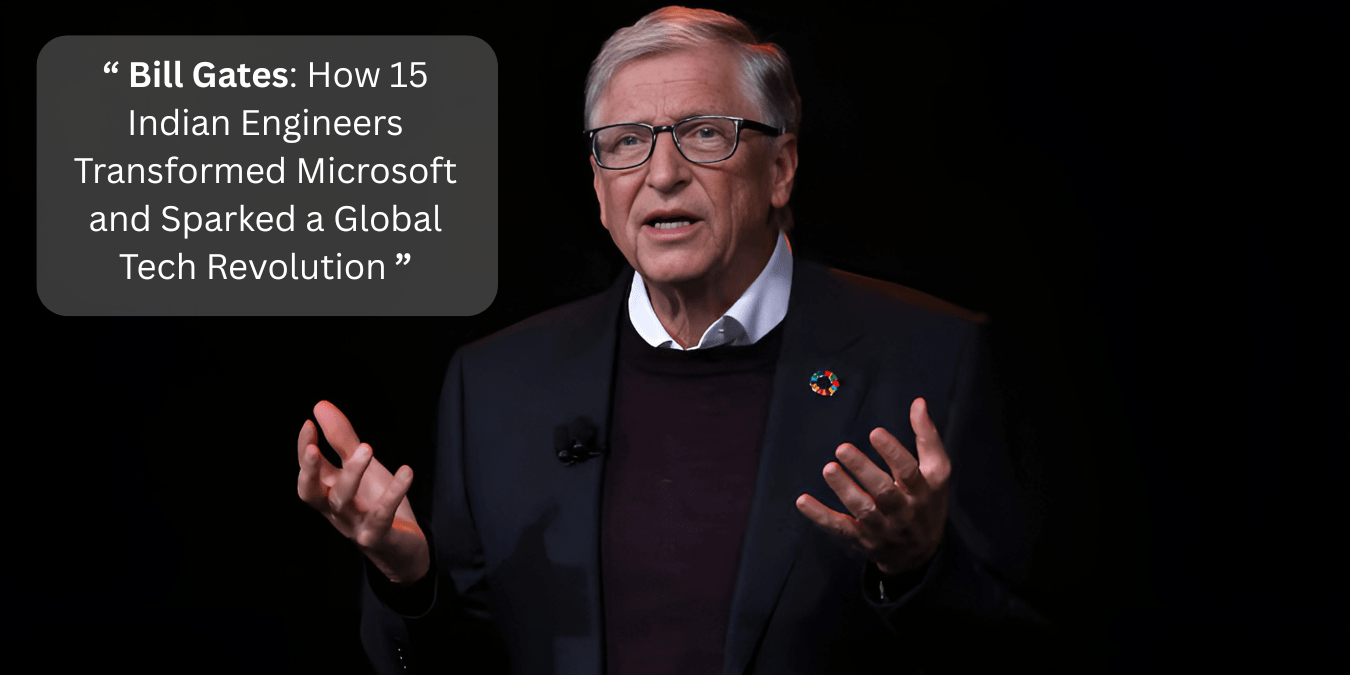
Bill Gates’ Game-Changing Moment: How 15 Indian Engineers Transformed Microsoft and Sparked a Global Tech Revolution
Did Bill Gates’ bold gamble in the 1980s spark a global tech revolution? By hiring 15 Indian IIT engineers, he transformed Microsoft from a struggling startup into a tech titan. Their code shaped Windows, their vision fueled innovation, and their legacy lives in 2025’s $250 billion Indian tech empire. As H-1B debates rage, this untold story of grit, genius, and global impact will leave you stunned.
Every era has a defining story, a single decision that shifts the course of an entire industry. For the global technology sector, Bill Gates’ mid-1980s choice to hire 15 Indian engineers is exactly that pivotal moment. As debate swirls in 2025 around talent, immigration, and innovation—with new H-1B visa rules, record-breaking valuations, and India’s tech rise dominating headlines—this origin story offers both a lesson and inspiration.
In a now-viral video from his 2024 IIT Delhi speech, Gates reflected: Microsoft, then a fledgling company with just a few hundred employees, struggled to find engineering talent in the U.S. A senior colleague suggested India’s IITs. They hired 15 graduates—a move Gates calls “phenomenal” and the true turning point in Microsoft’s history.
In the 1980s, a young Microsoft faced a talent crunch that threatened its survival. Bill Gates’ bold decision to hire 15 Indian engineers from the Indian Institutes of Technology (IITs) became a defining moment, not just for Microsoft but for the global tech industry. In 2025, as India’s tech exports soar and debates over global talent mobility intensify, this story remains a powerful lesson in innovation and inclusion. Gates himself, in a 2024 IIT Delhi speech, called this move “phenomenal,” crediting it with shaping Microsoft’s rise to dominance.
The Struggles of Young Microsoft: Talent Gaps and Growing Pains
Why Did Microsoft Look to India?
In the mid-1980s, Microsoft was a small company competing against giants like IBM. The demand for software engineers outstripped supply in the U.S., where top computer science programs produced limited graduates. A senior colleague pointed Gates toward India’s IITs, known for their rigorous training and exceptional talent. These institutes were producing engineers with unmatched skills in coding, problem-solving, and systems thinking.
- In the 1980s, Microsoft faced intense competition and a scarcity of elite engineers in the U.S..
- Demand for software and personal computers was exploding, but top U.S. computer science programs produced limited graduates.
- Gates’ network realized Indian Institutes of Technology (IITs) produced highly skilled engineers who were ready for global challenges.
The Decision That Defied Critics
Hiring internationally was controversial. In India, critics decried “brain drain,” fearing the loss of talent. In the U.S., some opposed foreign workers, citing job competition. Gates ignored the noise, trusting the IITians’ potential to drive Microsoft’s growth.
- The idea was controversial in both India (accusations of “brain drain”) and the U.S. (fears about foreign workers taking jobs).
- Gates trusted the advice and pushed forward, recruiting 15 IITians who became part of Microsoft’s engineering core.
- Media scrutiny was intense, but the need for technical expertise and innovation overrode the critics.
How Indian Engineers Transformed Microsoft
Building Microsoft’s Engineering Backbone
The 15 IIT graduates brought technical brilliance and a relentless work ethic to Microsoft. They worked on foundational projects like Windows and Microsoft Office, ensuring scalability and quality. Their contributions helped Microsoft evolve from a niche software firm to a global leader.
- The recruited IITians brought deep technical knowledge, creative problem-solving, and a relentless work ethic.
- They tackled foundational projects—helping develop Windows and Office, shaping Microsoft’s technology stack, and ensuring quality and scale.
- These engineers helped Microsoft transition from a niche software provider to a global powerhouse.
The Ripple Effect Across Microsoft
Many of these engineers rose to leadership roles, mentoring future generations. Their success paved the way for thousands of Indian engineers to join Silicon Valley. The “brain drain” narrative flipped to “brain gain,” as their contributions elevated global tech innovation.
- Many of these original IITians rose to leadership roles, inspiring future waves of Indian-origin talent.
- Their contributions helped lay the groundwork for later advances, from cloud computing to enterprise solutions.
- Microsoft’s success opened doors for thousands of Indian engineers in Silicon Valley, turning “brain drain” into “brain gain” for the world.
Indian Talent and the Modern Tech Revolution
Fast Forward to 2025: Indian-Origin Leaders Everywhere
In 2025, Indian engineers dominate global tech leadership. Satya Nadella, Microsoft’s CEO, symbolizes this legacy, steering the company into the AI era. Indian-origin CEOs lead Google (Sundar Pichai), Adobe (Shantanu Narayen), and IBM (Arvind Krishna), many tracing their roots to IITs.
- Satya Nadella, another Indian engineer, now leads Microsoft into the artificial intelligence era, symbolizing the lasting impact of Gates’ hiring decision.
- Indian-origin CEOs head major tech firms: Google, Adobe, IBM, and others—many got their start in the same IITs.
- In 2025, Indian data engineering and software exports reach new highs, fueling GDP growth and earning global respect.
The H-1B Debate: Then and Now
The 1980s hiring decision sparked debates about foreign talent, a topic still relevant in 2025. New H-1B visa fees, reaching $100,000 in September 2025, have reignited discussions about global talent mobility. Gates’ story is a reminder that inclusive hiring drives innovation, while restrictive policies risk stifling it.
- Visa challenges: High fees complicate global talent acquisition.
- Innovation at stake: Openness to talent fuels tech leadership.
- Historical proof: Microsoft’s success underscores the value of global hiring.
How-to Steps: Lessons for Today’s Innovators
Building a World-Class Team—What Companies Can Learn
- Look Beyond Borders: Cast a wide net—talent can be found in surprising places.
- Prioritize Skill and Passion: Credentials matter, but so does innate curiosity and drive.
- Create a Supportive Culture: The original Indian hires at Microsoft thrived because they felt valued and were challenged with meaningful work.
- Champion Diversity: Bringing together people from different backgrounds sparks creativity and new ideas.
- Invest in Ongoing Learning: Encourage constant upskilling and exposure to global best practices.
Pro Tips for Indian Engineers Aspiring to Global Careers
Indian engineers aiming for global impact in 2025 should focus on:
- Foundational skills: Master coding, algorithms, and systems thinking.
- Communication: Develop clear, collaborative communication habits.
- Networking: Seek mentorship to open doors to global opportunities.
- Adaptability: Stay agile in fast-evolving tech landscapes.
- Emerging tech: Stay updated on AI, cloud computing, and cybersecurity trends.
Common Mistakes: Pitfalls to Avoid When Seeking Top Talent
Companies often stumble when recruiting globally. Avoid these errors:
- Focusing Only on Elite Schools: Potential exists beyond big-name institutions—diversity widens the pool.
- Neglecting Onboarding: A strong onboarding process ensures international hires integrate smoothly.
- Overvaluing Experience, Undervaluing Learning Agility: Many game-changing hires were fresh graduates—potential often trumps tenure.
- Underestimating Cultural Fit: Teams work best when new joiners’ values align with company culture.
- Ignoring Global Policy Shifts: Visa, immigration, and remote work rules can change—adapt quickly.
Action Items: Maximizing Talent in 2025 and Beyond
To harness global talent like Gates did, take these steps:
- Encourage tech firms to invest in partnerships with Indian institutes for joint research and exchange programs.
- Support policies that make visa processes fair and transparent, benefiting both sending and receiving countries.
- Invest in reskilling Indian engineers for emerging technologies—digital transformation never stands still.
- Celebrate diverse innovation paths—the next Satya Nadella or Sundar Pichai can rise from anywhere.
The Legacy: India’s Ongoing Impact on Global Technology
India’s tech sector is a global powerhouse in 2025, with software exports exceeding $250 billion and data engineering valued at $42 billion. Indian engineers drive breakthroughs in AI, fintech, and cybersecurity. IITs continue to attract global recruiters, fostering research and innovation. Gates’ decision remains a beacon for aspiring engineers worldwide.
- India’s software sector is now a global engine, with exports in 2025 expected to exceed USD 250 billion, and data engineering valued over USD 42 billion.
- Indian engineers continue to drive major breakthroughs in AI, fintech, cybersecurity, and more.
- The IITs remain a magnet for global tech recruiters and major research collaborations.
- Stories like Gates’s continue to inspire hundreds of thousands of young Indians to dream big and compete on a world stage.
Narrative: Personal Glimpses and Ripple Effects
Arun, one of the original 15 IITians, recalls his first day at Microsoft’s Redmond campus in 1985. The foggy Washington air contrasted with the warm buzz of a small office where he coded alongside Gates. Fueled by chai and ambition, his team worked late nights to build software that would change the world. These engineers became mentors, bridging India and Silicon Valley, and their legacy lives in today’s global tech corridors.
Featured Snippet: Key Takeaways
- Bill Gates’ decision to hire 15 Indian IIT graduates in the 1980s transformed Microsoft’s trajectory and catalyzed the global rise of Indian tech talent.
- Microsoft’s success story demonstrates the power of inclusive hiring, bold leadership, and global collaboration to drive innovation.
- The profound impact of early Indian engineers is visible today in the leadership of major tech firms, record-breaking contributions to the software industry, and ongoing Indo-American partnerships.
Final Thought and Call to Action
The story of Bill Gates, Microsoft, and the 15 Indian engineers is more than just history—it’s a blueprint for every startup, corporation, and nation seeking to unlock the next big leap in technology. In India, young engineers should take inspiration: the world’s biggest stages are open to those with courage, skill, and vision.
Are you ready to be part of the next chapter? Learn, adapt, lead—because the next wave of transformation might just start with you. Explore new opportunities, follow the path blazed by legends, and let Indian talent continue to shape the future, one global breakthrough at a time.




























